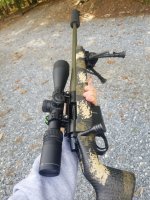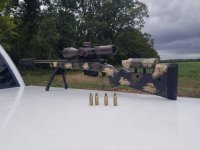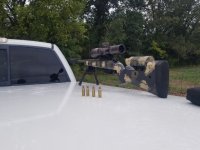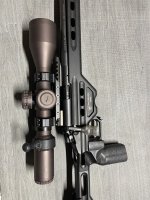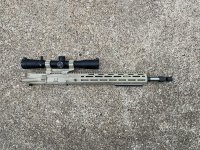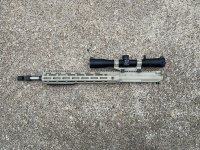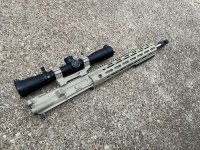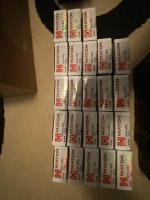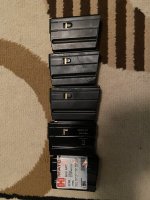Couldnt get the link to post without a subscription to the NY Times. Fuc them, so I copied it. Worth the read.
More Americans and freedom loving people everywhere need to pay attention to what Si said in this article. There is still evil assaulting us.
"Whatever it takes to stop this evil."
=======================================
He Bombed the Nazis, Outwitted the Soviets and Modernized Christmas
Laurie Gwen Shapiro
Sun, December 19, 2021, 11:15 AM
Si Spiegel, 97, at his home in New York, Dec. 18, 2021. (Carly Zavala/The New York Times)
The B-17 he was piloting had lost two of its four engines to enemy fire, and as Si Spiegel surveyed the ruined landscape, he had one thought: We have to get behind the Russian front.
As part of the Allied raid on Berlin, his bomber had dropped its payload over the German capital, but he’d been hit with flak and would almost certainly not make it back to the base in England. No pilot wanted to get shot down over Nazi Germany, especially not a Jewish pilot.
Spiegel had essentially bluffed his way into the cockpit as a skinny teenager from Greenwich Village, trusting he’d figure it out as he went. This was no different. He told his crew they were headed for Poland; they could get their parachutes ready, but were not to bail out unless he gave the order. They would attempt an emergency landing.
Sign up for The Morning newsletter from the New York Times
Si Spiegel is one of the last bomber pilots of World War II still with us. I met him on a windy December morning in 2019. I happened to overhear him discussing Eleanor Roosevelt’s love of aviation in front of her sculpture on Riverside Drive. I couldn’t help butting in — I was writing a biography of Mrs. Roosevelt’s great friend Amelia Earhart. He seemed wary of my enthusiasm, but when he saw the Lower East Side address on my business card, he smiled. I had inherited my grandparents’ old apartment in one of the International Ladies’ Garment Workers' Union buildings, the same address where his union parents had lived.
He invited me over for coffee that week. What began as a way to do research for my book — there aren’t many living aviators from that era, after all — evolved into a series of conversations over weeks and then months. His considerable charm and sharp memory were matched by his stamina — he would happily talk for hours but only if they didn’t conflict with his regular gym workouts.
But he was 95 then (now 97), and he clearly had been needing an audience for his stories. In the first hour of our first meeting, I learned that he flew dozens of critical and dangerous missions during the war, had saved his crew by successfully crash-landing an enormous bomber in no-man’s land — and then helped orchestrate a daring escape back out.
Perhaps most remarkable: Spiegel is improbably best known as “the king of the artificial Christmas tree.”
Si Spiegel was born in New York City in 1924, the first year of the Macy’s Thanksgiving Day Parade and the last year that Ellis Island operated as an immigration station. It was the Jazz Age, and Si wore button-up knickers. He remembers his first zip-up fly and when his family got their first telephone. They would crowd around the radio, especially whenever the president gave an address. “Roosevelt,” he said, “was our hero.”
He was tuned to the radio the day Amelia Earhart disappeared over the Pacific. And when Pearl Harbor was attacked, Si was 17 years old and living near his father’s hand laundry in Greenwich Village.
After graduating from Textile High School, he went to work in a machine shop, but he wanted to fight the Nazis. So without telling his parents, Spiegel enlisted in the Army shortly after he turned 18. He was a reedy youth, 5-foot-7 and 150 pounds. In basic training, noting his machine-shop skills, they sent him to aircraft mechanic school at Roosevelt Field on Long Island. He was crestfallen.
“How would I fight Hitler with a wrench?” he recalled thinking.
A sympathetic officer in the hangar with him suggested he go to Mitchel Field, just a couple of miles by bus. Maybe they’d take him as a pilot. Unlike the recruitment office at Times Square, the one at Mitchel Field was deserted. It set his life on a different path.
“I signed up in an unusual place already in uniform, and there were only two of us that day,” Spiegel recalled. “The other fellow was foiled by the eyesight tests. I had perfect vision.”
He was accepted into pilot training, which took him to Nashville, Tennessee, then California and then, as a cadet, to Hobbs, New Mexico, where he’d learn to pilot a B-17, the massive bomber known as the Flying Fortress.
Many military men were chain-smoking drinkers when not on duty, but Spiegel, still a teenager, never smoked or drank much or hit the brothels. “Maybe I had a lot of opportunities as a new pilot, but I was too shy to recognize them or take advantage.”
Hobbs had one thing of interest, a girl named Frankie Marie Smith. She was only 17 and a beauty. Back in high school, Si Spiegel would never have thought he had a chance with a girl like that. But now he was a dashing lieutenant who flew a B-17.
Within weeks, they were married in Lovington, New Mexico. “Her father insisted we get married in an Evangelical church, the Church of God,” Spiegel said. When they parted, Frankie Marie gave him a photo he would carry during missions. Then he left New Mexico and went to meet his crew, a motley collection of “leftovers.”
“We had five Catholics, two Jews,” he said. “Catholics weren’t treated too well, either. We had a Mormon, too.” Spiegel said the only WASP was a ball-turret gunner who had gotten into trouble with the law in Chicago. “And a judge said, ‘You have two choices,’” he recalled. “‘You can go to jail or join the Army.’”
Spiegel has outlived all of his crew members but still holds their stories. His bombardier and first real friend in the service, Danny Shapiro, was later shot down on another plane and held as a prisoner of war for a year. Dale Tyler was the Mormon tail gunner from Utah who came from a family of 13. “Harold Bennett was my top turret gunner, from Massachusetts. Killed in a training accident on another plane. His chute never opened.”
They were assigned to the U.S. 8th Air Force, and their base of operations would be in an English town called Eye, near the coast about 100 miles northeast of London.
Spiegel’s first flight in formation, at age 20, was a short mission over Belgium when the Germans were retreating. “We were bombing them to prevent blowing up a bridge,” he said. It was what airmen would call a “milk run” — a mission with little danger. “I thought, oh, this is great!”
Over the next year, Spiegel would carry out 35 missions, all of them in daylight, which conferred a strategic advantage but often resulted in significant casualties.
Their odds of survival were terrible. More than 50,000 American airmen lost their lives in World War II, mostly on B-17s and B-24s. The 8th Air Force suffered 40% of all casualties in the air war.
Mission 33 is what he often relives when reflecting on his war years.
It was an early-morning departure on Saturday, Feb. 3, 1945, a maximum-effort campaign now studied by military historians as the Berlin Mission. An overwhelming force of 1,437 bombers and 948 fighters took off from the English countryside to hit the Third Reich’s Luftwaffe headquarters.
“They said we were bombing Berlin headquarters,” Spiegel recalled. In his previous missions, he said, he had never given much thought to where the bombs fell. But as he approached Berlin, it suddenly dawned on him that this would not be a precision raid against a military installation. “With 2,000 planes, and it’s pattern bombing,” he said, “we’re bombing civilians. But our command wanted to get the war over with.”
He had thought about this a lot over the years. What he thought then, he agrees with now: “Whatever it takes to stop this evil. We went on a mission, we dropped bombs, we came back. As far as other bombers, I’ve gone to a lot of reunions, and I never heard any regret.”
The plane had an engine malfunction early in the flight, not unusual on a B-17. But over the target in Berlin, he lost the second engine to flak, and fuel was leaking.
Spiegel said he could keep up with the formation with one engine gone. With two, it was impossible. To make it back to England, they would have to fly into a headwind and back through a flak area. “We would be losing altitude, which meant that they could shoot us from the ground.”
By this late stage of the war, the German forces had retreated to Germany, and the Soviets, American allies, were coming across Poland. Spiegel knew from radio broadcasts that the Soviets had taken Warsaw. He asked his navigator, Ray Patulski, to give him a heading for Warsaw. Spiegel thought they would be safe if they got past Russian lines. He told his crew to throw stuff out of the plane as they lost altitude: flak suits, extra ammunition, anything of any weight.
The radioman made contact with England and relayed their status: No one hurt, two engines out, attempting to land in Warsaw. The Brits said they would notify the Yank authorities. That was the last anyone heard from the plane for weeks.
The nine men reached Warsaw at 1:30 p.m. The city was rubble. A bridge lay torn and twisted across the frozen Vistula River. Looking for a place to land, they headed downriver until they spotted a single-engine plane with the Soviet red star. It was barely 200 feet off the ground.
Spiegel partly lowered his wheels and fired flares — a friendly gesture. The Soviet pilot wiggled his wings to indicate, “Follow me” and led them over forests, a treacherous flight path for such a huge plane. Eventually, they belly-landed in a frozen potato field in the village of Reczyn. No one was injured, although the aircraft would never fly again.
The Nazis had held much of Poland at one point, and Spiegel didn’t know if any Germans were still there. He and his co-pilot, Bill Hole, left through the hatch to be met by villagers.
“Amerikansky!” Spiegel hollered. Some of the gathering villagers hollered too. “Benzine! Benzine!” They wanted the gasoline — the benzine — that was leaking out of the plane and ran toward them with buckets to collect the fuel. The crew let them have it.
The Americans were soon taken to Plock, a small city north on the Vistula, where they were billeted in apartments the Russians took over from locals — and treated as heroes by the Soviets after the successful raid on Berlin. Then they were moved again, to the Polish city of Torun, where the Red Army had taken over an abandoned German airfield. There they met another American crew whose plane had made a landing at Torun. They expected to stay until a rescue plane arrived — a week at most.
The Americans were not prisoners, but they were not allowed to leave until Moscow approved — and they had no means to leave anyhow. Spiegel met the other pilot, a fiery Illinois officer named George Ruckman, whose plane had lost one engine to flak and had blown a tire in its landing.
Despite confinement, the Americans largely did what they pleased. Over the coming weeks, the crews would go down to the Vistula and spend the day target shooting with rifles lent by the Russians. But life at Torun was mostly waiting. They gave up hoping for the C-47 transport plane. The official status of those flying on the B-17 43-38150 during the Berlin Mission: missing in action.
The other pilot soon devised a wild escape plan. They would send a team to Spiegel’s wrecked plane, 70 miles away, and have them collect an engine and a spare tire and return to Torun. It would require stealth, courage and bribery.
Both American crews bartered with the Soviet soldiers. Several revolvers and a $10 fountain pen paid for the gasoline for their secret flight; a $75 wristwatch given to a Russian officer secured a Ford tractor to haul the second engine back. According to war records, with the $30 Ruckman had in his own wallet, he bribed Russian MPs to overlook the cutting down of two telephone poles needed as hoists.
Using salvaged tools left by the Nazis, the crews worked in plain sight of the other Russians, who seemed more concerned with random artillery fire and the possibility that German snipers were still in the area. The Americans feared too much attention, though, and Spiegel made sure to drink with the Russian officers in Torun, toasting Stalin, Roosevelt and Churchill, the day Ruckman had villagers hoist the plane in the potato field.
Early on St. Patrick’s Day, 1945, the Americans jumped into the jury-rigged plane and began to taxi along the frozen ground. A single Soviet guard waved frantically to stop. But the Russians never chased them as they cleared the field and lifted off. “Maybe they were relieved they didn’t have to feed us,” Spiegel offered.
Determined to avoid German anti-aircraft guns in their hobbled plane, the 19 men headed south, and eight hours later landed at an American air base in Foggia, Italy.
There the Red Cross had a party for the crew, giving them candy, cookies and much-needed toiletries — they hadn’t brushed their teeth since the bombing of Berlin. U.S. Army staff checked the escape plane, and other than a few loose bolts, it was fine.
After months of fearing Spiegel had been killed in action, his family in New York received a telegram from Italy shortly before April 3, 1945, the shared birthday of Spiegel’s younger brother and his father: “Am safe and well. Letters following. Happy birthday. Love.”
Spiegel led two more missions after making it back to England, though since he had been presumed dead, his belongings had already been sent to New York.
Spiegel returned home on Aug. 31, 1945.
He was given a hero’s welcome in his home on West 11th Street. Times Square had become an all-night party where military men were gods. Yet despite his 35 missions and multiple awards for bravery and exemplary behavior, Spiegel went to war as a first lieutenant and returned as one.
Looking back, having spoken to other Jewish GIs, he believes now that many Jewish soldiers were denied promotions because of antisemitism. He has some thorny memories: Many heroes in the Army Air Corps joined the commercial airline industry after the war, which was then based in New York. But here too, Spiegel said he faced discrimination. “They weren’t taking Jews after World War II,” he recalled. “They were blatant.”
Frankie Marie Spiegel joined him in New York for several months before they moved back to New Mexico. Spiegel got a job there as a radio announcer on a country and western program. (He went by the name of Muddy Boots.) But the marriage soon soured. They had no children, and he made a clean break, returning East.
It was a vibrant time in Greenwich Village, and he joined Pete Seeger’s Good Neighbor Chorus after the war and made new friends. And in midsummer of 1949, he went to Camp Unity, a leftist camp in Wingdale, New York.
Within hours he met a young woman named Motoko Ikeda. She was an artsy girl in pigtails, and he was fascinated by her. She was frank about her time in an internment camp during the war. It was eye-opening.
Her parents were born in Japan, and her family of six, she told him, had been forcibly sent from Los Angeles to a camp in Wyoming. At 14, she was kept behind barbed wire and watched by armed guards. After the war, many Japanese Americans held in the camps went back to California. Ikeda chose a one-way ticket to New York.
“Motoko was mental refreshment after divorce,” Spiegel says now. “I liked her because she was pretty, bright, patient and a good person. I wanted to learn more about her.”
They married in the Municipal Building around Thanksgiving in 1950, and a daughter, Kazuko, the first of their three children, was born in 1951. His blended family was accepted without reservation by his parents. “Motoko was better at Jewish food than my mother. She could cook in any language.”
Still frozen out of aviation, Spiegel went to vocational school and found a job as a machinist at a brush manufacturer in Mount Vernon for $1.80 an hour.
It was at the Westchester factory that his luck turned.
A strange design fad hit the country in the late 1950s: Shop designers were using millions of small multicolored brushes, which when assembled in department store windows looked, in his words, like “miniature pastel waves.” American Brush Machinery, where Spiegel was employed, fabricated machines to make these brushes, which could sell for $12,000 each — sound money, but then the fad died.
His bosses decided to repurpose the machines: They could make Christmas trees. The first ones they produced, out of green polyvinyl chloride plastic, didn’t look much like Scotch pines. Business was slow. Midcentury America liked futuristic aluminum trees lit by color wheels, and few people owned fake trees at all. Spiegel, by then a senior machinist, was sent to close the factory, but he reported back there was big money to be made. One boss thought he was out of his mind, but the other gave him his own division, called American Tree and Wreath.
Determined to improve on his product, Spiegel brought in real trees to study. He tinkered with his machines to speed up the process, and soon he was selling quickly made and perfectly shaped fakes.
By the mid-1970s, Spiegel’s company, American Tree and Wreath, was producing about 800,000 trees a year, one off the assembly line every four minutes.
After expanding and starting his own artificial tree company, he finally sold that business and retired in 1993 as a multimillionaire.
He had been a workaholic, and now he wanted to travel with Motoko and enjoy life. She had become an accomplished painter and was inspired by new places, from Paris to Japan. But after her sudden death in 2000, Spiegel found himself drawn powerfully to military reunions and the company of veterans.
He became involved in a couple of Army Air Corps historic associations, enjoying the camaraderie of the airmen, who understood his night terrors and late-diagnosed PTSD. These society gatherings continued in dwindling numbers until about 2012. Now, as far as he knows, he is the only member from World War II.
Eventually, his daughter Kazuko Spiegel introduced her father to the woman who would become his third wife, JoAnn Bastis, a real estate agent she had met in Westchester social circles. They would be married only for a few years before she died in 2018, though the couple traveled in Europe together twice, including a visit to Reczyn, the tiny village where he belly-landed in 1945.
Spiegel now lives in a large apartment building with a doorman and a magnificent view of Central Park. Although artificial trees descended from Spiegel’s designs are found in close to three-quarters of the American homes that put up Christmas trees, he doesn’t keep a tree himself.
He raised his children to take pride in their Jewish-Japanese heritage, and he still makes the Hanukkah latkes for his grandchildren. But when his children were young, they always had a tree, first a real one, and then the best of his fakes. “Do you think Christmas trees were really a religious symbol? They were pagan symbols. My kids liked them.”
When asked what he would like his legacy to be — artificial trees or military heroism — he closed his eyes.
The war, he admits, was probably the most exciting time in his life. Who’s left to talk about it with, though?
“I can tell you this,” he finally said. “We fought against fascism. We fought against Hitler’s desire for a master race.”
He is surrounded by pictures of his children and his grandchildren, and he worries about growing racism. “I never thought that fascism was a possible threat to our nation’s democracy until now,” Spiegel said. “Right now, however, all I’m trying to do is stay alive.”
 IMG_0633 2.JPG227.1 KB · Views: 182
IMG_0633 2.JPG227.1 KB · Views: 182 IMG_0636.JPG257.7 KB · Views: 193
IMG_0636.JPG257.7 KB · Views: 193 IMG_0638.JPG302.3 KB · Views: 204
IMG_0638.JPG302.3 KB · Views: 204 IMG_0639.JPG303.3 KB · Views: 186
IMG_0639.JPG303.3 KB · Views: 186 IMG_0640.JPG312.5 KB · Views: 178
IMG_0640.JPG312.5 KB · Views: 178 IMG_0654.JPG335.5 KB · Views: 172
IMG_0654.JPG335.5 KB · Views: 172 tempImage55ZdhE.png2.8 MB · Views: 161
tempImage55ZdhE.png2.8 MB · Views: 161 IMG_0652.JPG862.2 KB · Views: 147
IMG_0652.JPG862.2 KB · Views: 147 IMG_0651.JPG900.5 KB · Views: 150
IMG_0651.JPG900.5 KB · Views: 150 IMG_0650.JPG330 KB · Views: 154
IMG_0650.JPG330 KB · Views: 154 IMG_0649.JPG403.9 KB · Views: 142
IMG_0649.JPG403.9 KB · Views: 142 IMG_0648.JPG270.4 KB · Views: 146
IMG_0648.JPG270.4 KB · Views: 146 IMG_0647.JPG229.3 KB · Views: 133
IMG_0647.JPG229.3 KB · Views: 133 IMG_0646.JPG233.6 KB · Views: 148
IMG_0646.JPG233.6 KB · Views: 148 IMG_0645.JPG195.7 KB · Views: 133
IMG_0645.JPG195.7 KB · Views: 133 IMG_0643.JPG229.2 KB · Views: 122
IMG_0643.JPG229.2 KB · Views: 122 IMG_0642.JPG248.4 KB · Views: 111
IMG_0642.JPG248.4 KB · Views: 111 IMG_0635.JPG137.9 KB · Views: 184
IMG_0635.JPG137.9 KB · Views: 184









